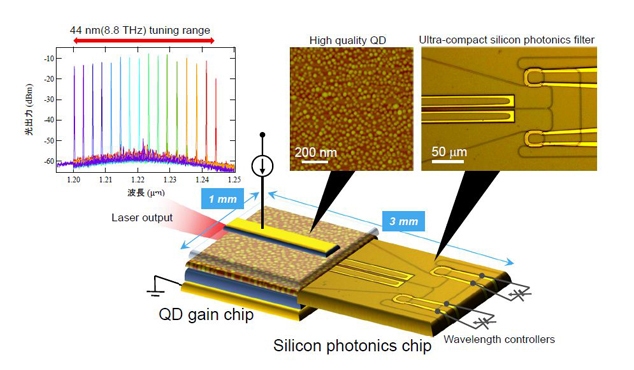Jun 4 2015
Researchers at Tohoku University and the National Institute of Information and Communications Technology (NICT) in Japan, have developed a novel ultra-compact heterogeneous wavelength tunable laser diode. The heterogeneous laser diode was realized through a combination of silicon photonics and quantum-dot (QD) technology, and demonstrates a wide-range tuning-operation.
 A novel heterogeneous wavelength tunable laser diode consisting of QD technology and silicon photonics.
A novel heterogeneous wavelength tunable laser diode consisting of QD technology and silicon photonics.
The researchers presented their work at a Conference on Lasers and Electro-Optics (CLEO) in San Jose, California, on May 13. The related paper was also published in Applied Physics Express vol. 8, 062701 on May 20.
Recent high-capacity optical transmission systems are based on wavelength-division multiplexing (WDM) systems with dense frequency channels. The frequency channels in C-band (conventional band: 1530- 1565 nm) are overcrowded and the frequency utilization efficiency is saturated in such WDM systems. On the other hand, extensive and unexploited frequency resources are buried in near-infra-red wavelengths (1000-1300 nm). Additionally, photonic devices are required to have smaller footprints and lower power consumption in short-reach data transmission. The compact and low power consumption wavelength tunable laser diode is a key device to tap the undeveloped frequency bands for higher capacity data transmission systems.
The heterogeneous wavelength tunable laser diode, consisting of the QD and the silicon photonics, is a promising candidate to realize such a compact and broad-band light source. This is because the QD has large optical gains of around 1000-1300 nm wavelength, and silicon photonics provide a promising platform for highly integrated photonics devices - so a novel wavelength-tunable laser diode, combining QD and silicon photonics technologies, was proposed.
The cooperative research group led by Tomohiro Kita and Naokatsu Yamamoto demonstrated a wide range tuning operation of around 1250 nm wavelength with an ultra-small device footprint. The obtained frequency tuning-range of 8.8 THz is a world record for the category of QD and silicon photonics heterogeneous wavelength tunable laser diodes. It is expected that the fusing of the QD technology and silicon photonics will provide a breakthrough for the development of an effective and compact light source.
This research was partially supported by the Strategic Information and Communications R&D Promotion Program (SCOPE) of Japan's Ministry of Internal Affairs and Communications.